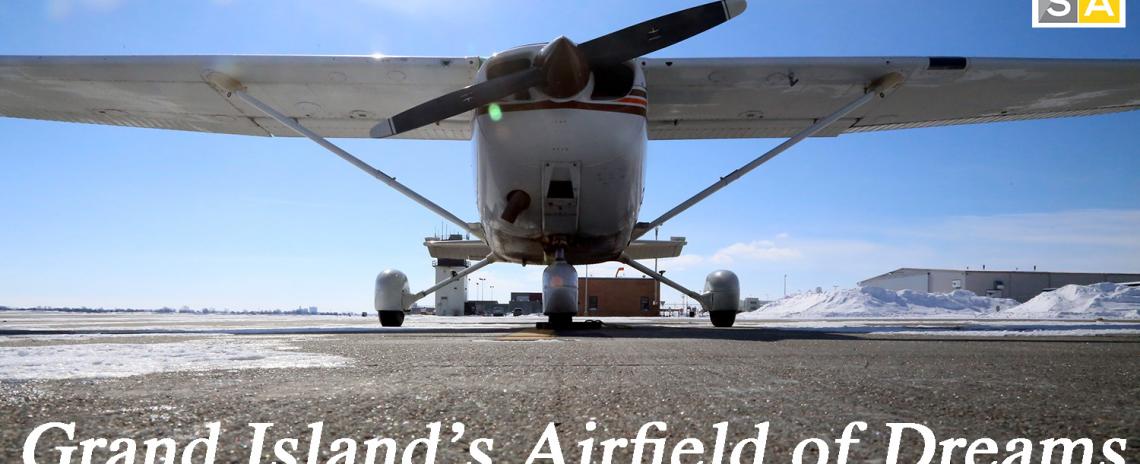Grand Island's Airfield of Dreams: Students take pioneering aviation pathway to the sky
Grand Island's Airfield of Dreams: Students take pioneering aviation pathway to the sky
By Tyler Dahlgren
The front doors of Trego-Dugan Aviation swing open, letting in a gust of a pleasant, early-spring Grand Island wind before closing behind a man wearing khaki slacks, a black and red Cornhuskers leather jacket and at least two forms of identification swinging from the lanyard around his neck.
T.J. Norris juggles a fascinating combination of job titles. Part teacher, part flight instructor. Or, more accurately, full-on teacher and full-on flight instructor, but there’ll be more time to get into that later.
Right now, T.J.’s heading down the hall at a quick pace. He exchanges friendly introductions with another storyteller curious about one of the state’s most innovative academic ventures and pushes open another set of doors that leads to the runways of Central Nebraska Regional Airport.
We make a right turn at the famous “Rocket Bob” statue, stopping briefly for a photograph with Trego-Dugan’s adopted mascot, and head toward the avionics shop. Norris points to the Air Traffic Control Tower, the only one in the state west of Lincoln. Pre-pandemic, his students were given access and tours of the tower, along with most other sectors of the airfield and the Trego-Dugan grounds, where internships are offered and doors to career opportunities are opened.
“This is a special, special opportunity,” said Norris, whose employment by both Trego-Dugan and GIPS is a fitting and symbolic testament to the partnership that exists between the two. “Trego-Dugan has been, by far, our greatest ally. They have been a huge advocate for our kids and for our program. They work seamlessly with us, care about our kids and have hired some of our students.”
There are 30 students in Grand Island’s Aviation Flight Pathway and another 10 in the Aviation Technician program. Part of the district’s acclaimed Career Pathways Institute, it’s a program unlike any in the state, and very few in the entire country.
What makes this program so unique and the only of its kind?
Well, just look up.
Beyond the state-of-the-art flight simulators at the CPI campus where students get their first feel of flight. Beyond the shop across the hall where future mechanics grind in elbow grease on actual aircrafts. Beyond the engaging Mr. Norris, who toes the line between flight instructor and classroom educator with passion and infectious energy.
“The goal from the jump was to fly,” said Academy of Engineering and Technology principal Matt Wichman.
Look up there, past the clouds and into the sky Grand Island students are now provided free lessons to fly. That’s where this pathway leads.
“If we’re serious about helping kids learn, giving them an airplane ride is phenomenal, but giving them flying lessons or providing the mechanism to do that makes the program an actual program,” said Norris. “It’s a phenomenal experience for our students, an opportunity to shake the stick, to look outside and see the city of Grand Island from a thousand feet.”
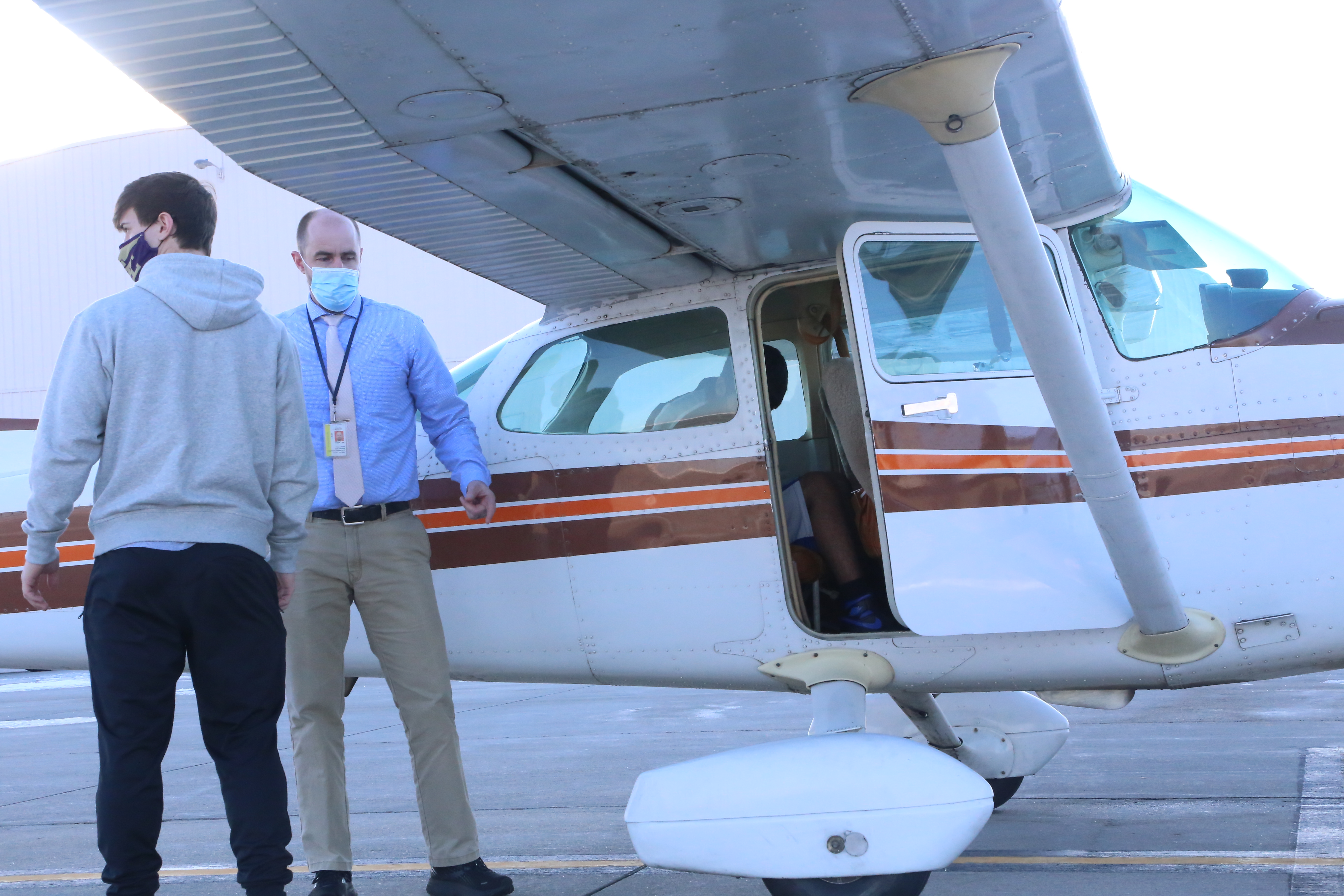
(Pictured Above: T.J. Norris standing next to the Cessna 172 he uses in providing flight lessons to Grand Island students. Photo Courtesy of GIPS)
Students flying airplanes, obviously, will steal most of the headlines (including this one), but it’s the work done by CPI students outside of the cockpit that really serves as a stepping stone towards a career in aviation.
As cutting edge as the program is, there’s no realistic scenario in which a student graduates from high school and strolls into a career as a pilot for any of the big guys like United, Delta or FedEx.
“But they’re going to need some kind of a foot in the door,” Norris said. “Many people, not just high school students at Grand Island, got their foot in the door by being a lineman or marshaling and fueling planes. It’s a way to be around.”
And thanks to the graciousness Trego-Dugan has shown, Norris’s students are around these grounds a lot, immersing themselves in the behind-the-scenes operations responsible for making an airport go. They do time on the line, fueling trucks, driving the tug, loading luggage and marshaling planes onto the runway. They work hard, learning something new every minute.
“It’s not always glamorous, but it is a spectacular first step into the airline business,” Norris said.
Trego-Dugan employees have grown used to having the students around. They’re welcoming and willing to help in any way they can. They know the vocation and enjoy sharing the ins and outs of the day-to-day operations, knowing it’s important for any industry to invest in the future. Especially when that investment is made so close to home.
“Their questions have continuously gotten better over time,” said Director of Avionics Caleb Hopkins. “That’s not to say their questions weren’t good before, but I think their understanding of an aircraft in the aviation industry evolves as they get into their second and third year in the program. They gain a better understanding of everything around them.”
Pound for pound, avionics are the most expensive and the most frustrating parts of an airplane, encompassing everything a pilot sees in front of them during a flight. There's much to learn, and the shop takes on an intern and Norris swings by with his other students frequently.
“We have developed a good relationship,” said Norris. “Caleb is very gracious and I have brought my students here on numerous occasions and annoyed him, bothered him, and gotten tours of his shop.”
Student engagement is more attainable while standing next to a runway. It’s easy to flood students with information in the classroom. It’s not so easy out here.
“If somebody is talking fast and they’re just like a fire hose of all this information, then kids will pop out and they’re done learning for the day,” Norris explained. “It’s too bad there’s not a little meter on the side of them, actually. But because Trego-Dugan and Caleb specifically are so gracious and welcoming, we just come, come, come and come back again. The last time we left, the kids were like ‘That is so cool’ and they started telling me something that I have taught them in class three times. I’m like, ‘I’ve told you that three times’, but this particular time it made sense. Things just click out here.”
Hopkins said the team at Trego-Dugan enjoys having the students around. And though his road ended up here anyways, he wouldn’t have minded hopping on board sooner.
“I went to Grand Island Senior High too, and I would have definitely jumped at that opportunity," Hopkins said.
The students assimilate to their surroundings quickly. Things move fast and they're constantly on their toes.
“They’re smart kids,” Troy Shubert, a pilot and air frame and power plant mechanic who’s known to the students simply as Shubie. “A lot of them come from a farming background, working on their cars and things like that. They take quickly and it’s neat to see things change into a possible vocation.”
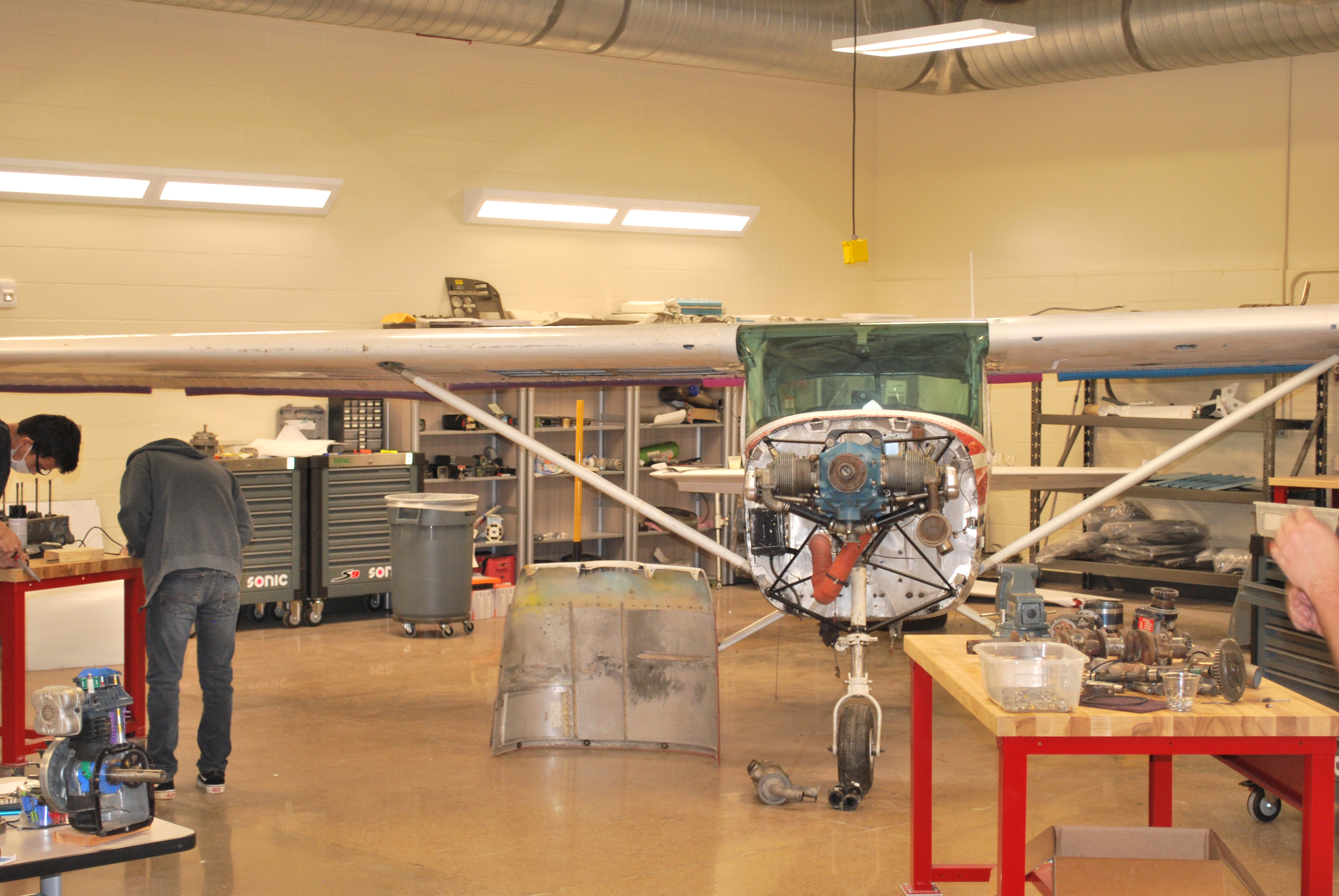
(Pictured Above: The Aviation Mechanics shop at Grand Island's Career Pathways Institute is always bustling with activity.)
Flying is the final frontier of the Aviation Pathway.
Putting students in the sky, as Wichman said, was the goal from the start, though that road was full of obstacles.
“That’s the golden nugget, like giving kids a chocolate bar, a natural high and a natural rush,” Norris said. “It’s unexplainable."
As the top flight instructor at Trego-Dugan, Norris has logged 120 hours instructing in a Cessna 172 over the last year, 25 of which have been with GIPS students. Over spring break, he had Trego-Dugan’s four interns in the hangar washing and waxing everything from the airplane to the floor upon which is sits—stationary today, but never for too long.
“That gave them an increased appreciation for this,” he said.
Back in their CPI classroom, a place that didn’t exist two years ago but now is lined with a variation of flight simulators and filled with both energy and opportunities, students study and then answer an array of questions from Norris trivia-style.
“There are advantages and disadvantages (to the simulators),” said Norris. “The advantage is obvious. It’s like eye candy. It’s amazing and they can do things without the danger of any sort of personal harm. We can stop. We can pause the session and I can explain to them what’s going on. The disadvantage is that it’s not real and so that notion of ‘This is real and important and I’ve got to pay attention’ is not there.”
Here’s where that “golden nugget” pays off. Without putting in the work in the classroom, students who have pilot aspirations never make it to the air, where the open horizon waits in place of high-definition screens. Up there, what they learn in here matters. Up there, what they learn in here is worth their life.
“Take-offs, I have found, are the most difficult to get used to because within the first three seconds in a real plane your ears pop and your stomach is lying on the ground,” said senior Chris Brown. “In here, it’s not like that. It’s flat.”
The simulators are a phenomenal tool, said Norris, but they are just that.
“We still have to learn and we still have to use the tool properly,” he continued. “It doesn’t matter if it’s a wrench or a hammer, you have to know how to use the tool and you have to use it properly to be effective.”
Brown grew up wanting to fly airplanes. Since his uncle took him along to an airshow when he was a boy, he's wanted to be a pilot. That dream never wavered, though he didn’t expect a chance to start chasing it so soon.
“I didn’t ever think flying would be part of school,” Brown admitted. “But I always knew that I’d be flying at some point in my life. I’ve always wanted to be a pilot.”
In addition to the lessons offered by the school, Brown is one of a few students who takes private lessons with Norris on Sundays. He talks about the opportunity he’s been afforded as a student and admits it’s sometimes hard not to brag about the experience, especially with that thousand-foot view.
The first time he saw his hometown from the cockpit of a plane HE was flying?
“Extraordinary,” Brown said. “The best feeling I’ve ever felt in my life.”
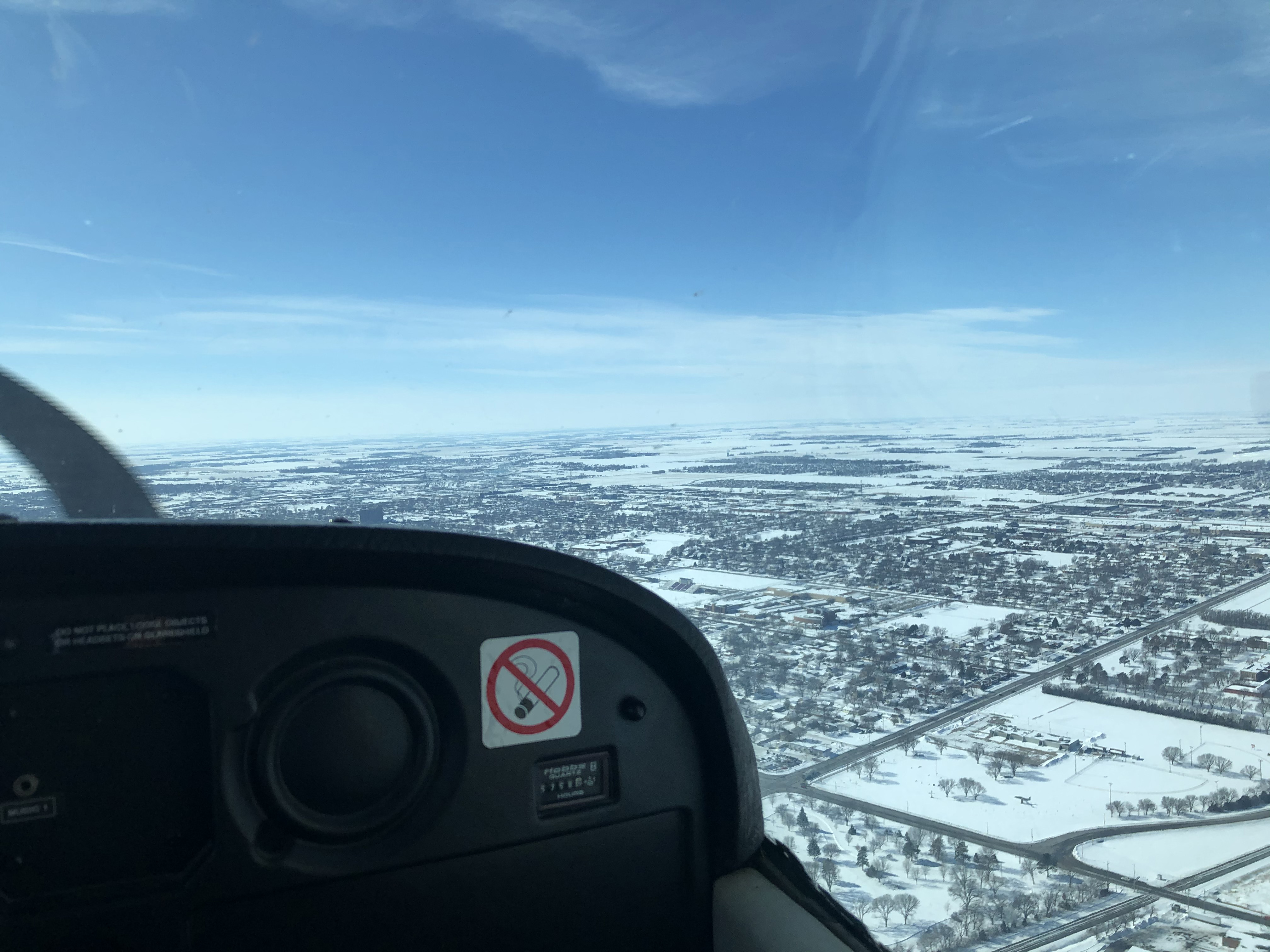
(Photo Courtesy of GIPS)
The runway leading to the runway wasn’t lacking obstacles. There were plenty of challenges.
Navigating and understanding the FAA’s rules and regulations and obtaining proper insurance were two of many tasks the GIPS administrative team, and specifically Director of Innovation for College and Career Readiness Dan Phillips, tackled along the way.
“Dan was really doing a lot of the legwork behind that, and it took a lot of time and effort,” said Wichman. “Part of the challenge was that where there were schools doing flight, they’re really somewhat unique circumstances or they’re doing it exclusively after school.”
They found one other school district, in Arizona, offering flying lessons to students during the day. As true pioneers in student aviation, there haven’t been many opportunities to collaborate with other districts.
“That’s where having a partner like Trego-Dugan has been so crucial,” said Wichman. “They're a much larger organization than I had realized. They have 40 locations across the country, from here to their headquarters in North Platte to Florida and all the way up to the state of Washington. They've been great to work with. Another lock was finding Mr. Norris here. Through collaboration, we’ve been able to bring the vision to life.”
When talking about Grand Island’s pathways, Wichman harps on the “access to opportunities” the school district strives to provide.
The school has a large portion of students who have never boarded an airplane, let alone pondered a future in aviation. Now, they have access to a new world of possibilities.
“As a person who has nearly 18 years of education experience, up until two years ago I could have never told a student how to become a pilot or about the breadth of careers that are available in that field,” Wichman said. “Our aviation pathway, and all of our pathways, really, are bringing about that access to opportunity that is so valuable to students.”
There’s a notion out there that career academies pigeonhole students, but Wichman feels that this belief couldn’t be further from the truth.
“As much as some of the youngsters in there are learning that this is what they want to do while becoming more and more passionate about it, we equally celebrate kids who learn what they don’t want to do,” Wichman said. “There’s a young lady we just passed in the mechanic shop. She wants to be an interior designer. She just thought it’d be fun to build an airplane. That’s awesome too, isn’t it?”
Awesome, indeed. In just two years, the program has produced an impressive list of success stories, but Norris knows that not all of his students will end up flying for major airlines or repairing Cessna 172’s.
And that’s perfectly fine.
“It’s hard to become a pilot,” Norris said. “They have to work hard at it and focus. They have to remember a lot of things. It’s glamorous and, at the same time, it’s not. It’s getting dirt under your fingernails and carrying your team’s hard work.”
No matter their destination, his students learn from the journey.
After all, it's a flight few students across the country are able to take.
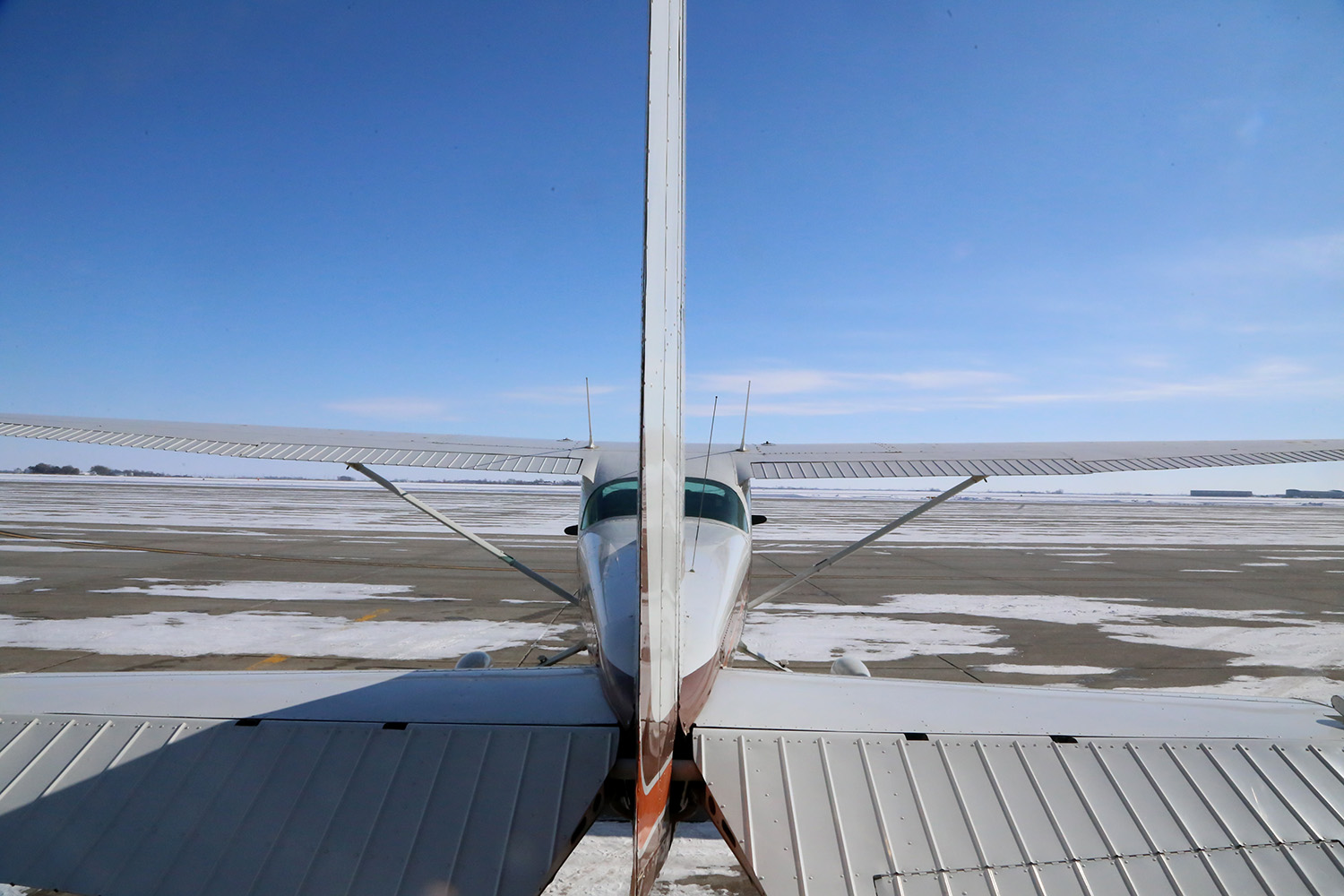
(Pictured Above: The Cessna 172 that Grand Island Aviation Pathway students fly during lessons provided by the school district. Courtesy Photo)

